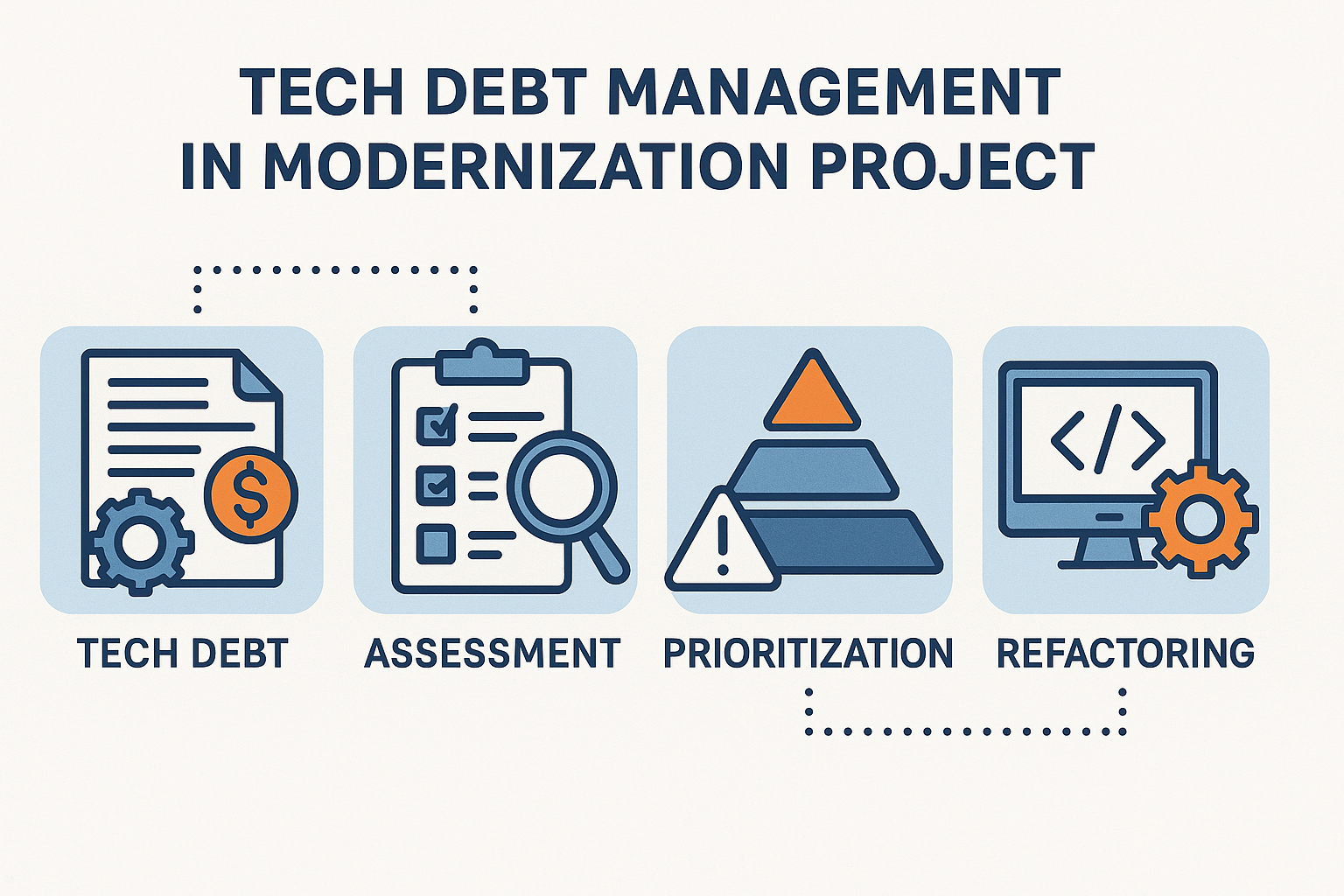Ever feel like you’re playing whack-a-mole with bugs and upgrade requests? One minute you’re adding a cool new feature, the next you’re knee-deep in outdated libraries, cryptic comments, and sprawling code you barely recognize. Welcome to the wonderful world of technical debt— that invisible interest you pay on shortcuts, outdated patterns, and hurried fixes. When you’re modernizing an application, tech debt can morph from a minor annoyance into a full-blown blockade. But fear not: with a solid strategy for identifying, prioritizing, and paying down debt, you can keep your transformation project on track without burying your team in endless refactoring sprints.
Understanding Technical Debt in Modernization
At its simplest, technical debt is the gap between the code you have and the code you wish you had. Unlike financial debt, which you can ignore until the bill arrives, tech debt accumulates “interest” with every change—sluggish builds, fragile code paths, unclear ownership, and mounting frustration. In a modernization project, debt often lurks in the monolith’s old modules: hard-coded configuration, monolithic services rife with conditional logic, outdated ORM layers, and a test suite that barely covers the happy path.
Why it matters:
Reduced Agility: Every new task takes longer because you need to untangle legacy spaghetti before you can move forward.
Increased Risk: Fragile code breaks in unexpected ways, leading to last-minute firefighting and production incidents.
Team Morale Impact: Developers dread working in debt-ridden modules, leading to knowledge silos or resistance to change.
Have you ever stared at a three-thousand-line controller class and wondered how anyone maintained it in the first place? That’s tech debt shouting, “Help me!” Let’s learn how to listen and respond.
A Step-By-Step Debt-Management Playbook
Step 1: Identify and Catalogue Debt
Begin by conducting a debt audit. Use static analysis tools—SonarQube, CodeClimate, or ESLint—to flag complexity hotspots, duplicated code, and test coverage gaps. Pair this with developer surveys: have each team member list the top three pain points in the legacy codebase.
Combine tool output and human insights into a Tech Debt Register—a living document that describes each debt item, its location, the suspected impact, and a rough effort estimate.
Anecdote: On one modernization initiative, our static scanner flagged over 1,200 code smells. We initially panicked! But after cross-referencing with our dev survey, we realized 80% of those issues were harmless naming inconsistencies. Focusing on the remaining 20% of critical smells—like untested conditional branches—saved us from chasing ghosts.
Step 2: Prioritize with Business Context
Not all debt is equally harmful. Map each debt item to business impact:
High-Impact, Low-Effort: Refactoring a core calculator function that fails edge cases— big win, quick fix.
High-Impact, High-Effort: Replacing an entire ORM layer—worth doing but requires roadmap alignment.
Low-Impact, Low-Effort: Renaming a private variable—nice but not
Low-Impact, High-Effort: Rewriting an old helper class with no known bugs—defer.
Create a debt backlog in your issue tracker, tagged by priority and iteration. That way, paying off debt becomes part of normal sprint planning rather than a dreaded “debt week” that teams avoid.
Step 3: Integrate Debt Reduction into Your CI/CD
Treat debt remediation like any other feature. Include refactoring tickets in your sprint scope, allocate a fixed percentage of velocity (e.g., 20%) to debt pay-down, and write tests before you refactor. On one project, we embedded gate checks in our pipeline: if cyclomatic complexity for a file climbed above a threshold, the build failed—forcing us to refactor before shipping new features.
Step 4: Continuous Monitoring and Feedback
Debt isn’t a one-time fix; it’s an ongoing companion. Monitor your code health metrics each sprint: track code coverage, complexity, duplication, and issues introduced versus resolved. In monthly architecture reviews, discuss trends and adjust your debt-budget percentage as needed. Visual dashboards keep everyone aligned and maintain momentum.
Overcoming Common Pitfalls
Debt Amnesia: Teams sometimes forget debt items or deprioritize them under feature pressure. Combat this by embedding debt items in every sprint and celebrating small wins publicly.
Over-Refactoring: Beware of perfect-code syndrome—refactoring for its own sake can stall feature Stick to “good enough” improvements that address real pain points.
Stakeholder Misalignment: Product owners may balk at paying down invisible Translate debt reduction into business terms—faster time-to-market, fewer incidents, happier customers.
Tool Overwhelm: Static analyzers can flood you with false Tune rules to focus on actionable debt and gradually expand coverage.
Conclusion
Technical debt management isn’t about erasing every flaw; it’s about consciously balancing short-term delivery with long-term maintainability. By auditing your legacy code, prioritizing debt by business impact, and weaving debt reduction into your CI/CD and sprint cycles, you’ll transform modernization from a daunting slog into a steady march toward cleaner, more agile code. Ready to tackle that debt register? Open your static analysis dashboard, poll your team for pain points, and schedule your first debt-pay-down sprint. Your future self (and your entire team) will thank you!





